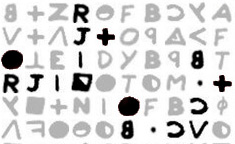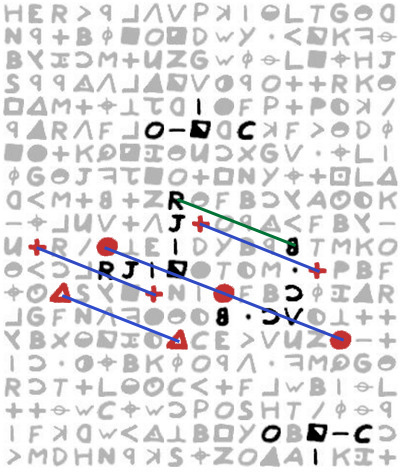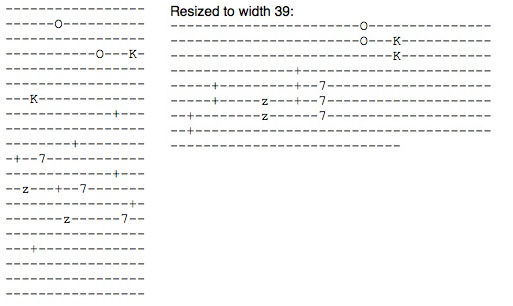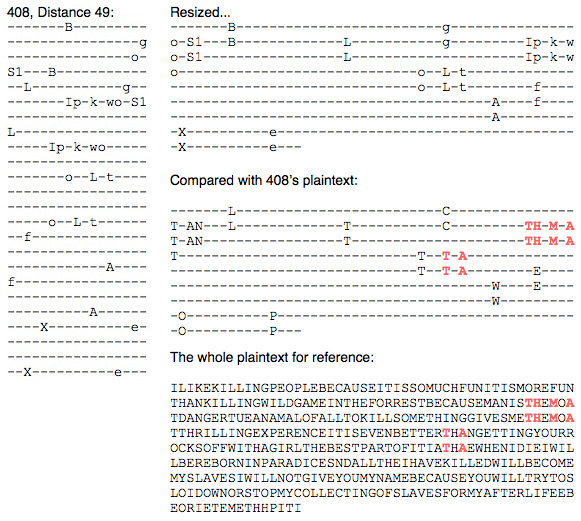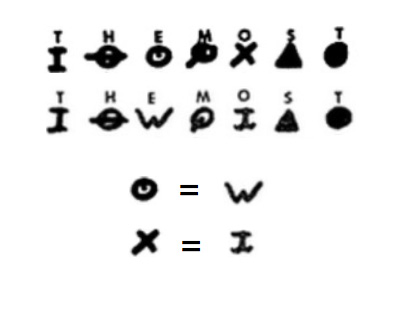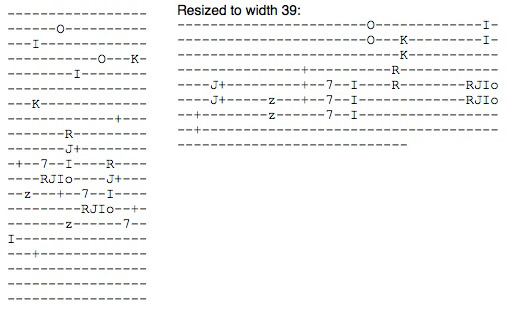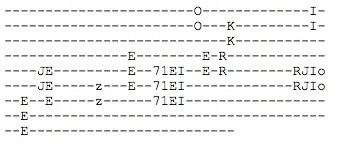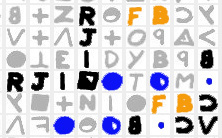Hi,
since I was not in the mood to work on my solver I decided to look at the pivots again for a moment. Unfortunately I had not much sleep and thus some patterns appeared before my eyes. Usually I think that patterns are no good but my finds became interesting anyway. So here is what I have found:
First I had checked which symbols are surrounding the pivots. I recognized the filled circle and the plus sign (not sure if this was mentioned before). On the image above you can see that a pattern can be found. After that I have determined the distance between the pivots (given that „R“ is the starting point of the left pivot and the reversed „B“ is the starting point of the pivot on the right). The distance is 39. Next I checked visually for more of those repeating symbols. This was the result:
As you can see there are a couple of symbols which repeats after a distance of 39. The green line shows the distance between the pivots and the blue lines are showing symbols with a distance of 39
Then I wrote a small script which checks the whole cipher for those repeats. This is the result:
„7“ maps to the filled circle, „z“ to the triangle. I am sorry that I did not convert the outputs from my script to the zodiac font :/
Now I did a similiar test with z408. This time I checked all distances from 1 to 400. The highest count of repeating symbols were found at a distance of 49:
The red marked letters show where in the cipher a text repetition can be found. As long as you do not have the plaintext this is just an evidence of course. But if you assume that a real text repeat has been found then some of the cipher symbols can be eleminated. In this case this would look as follows:
The results for z340 shown at the beginning of this post are not as good as the results found in z408. So I had the idea that the pivots could be map to the same plaintext letters („R“ and backward „B“ maps to the same letter e.t.c). So I replaced the pivot on the right by the pivot on the left and started my script again. This was the result:
The pattern „7–I" caught my attention because I had expeced that it should only occur twice. But because of the pivot replacing it now occurs three times. And all three times with the same distance! Maybe I found a repeating text snippet. So I checked which symbols are between „7“ and „I“ in the cipher text:
If these three snippets all contain the same plaintext, then „1“, „F“ and „-„ must be the same as well as „E“, „B“ and „+“. So I had replaced those letters an run my script once again:
I tried some further text replacements but I will not post them all because I don’t want to spam the whole thread.
What do you think this could be? A coincidence? An evidence of many text repeats? An evidence that the whole cipher is nothing more than a useless pattern of letters enciphered by homophonic substitution? Or do you think I should have more sleep instead of searching for non existing patterns?
Interesting stuff Largo,
In the other thread I talked about repeating bigram structures and it may be related. A possible link to repeating plaintext is interesting, also with the possibility of reducing the keyspace. Period 39 in the 340 is what I believe to be period 2 bigram repeats (after transposition) that shifted away from period 38 (somehow). If you mirror the 340 then period 19 bigram repeats become period 15 and period 39 becomes period 29.
Basicly what I believe is happening here (plethora of repeating patterns) is that there exist various harmonics between the plaintext, encoding, period and the grid dimensions that creates repeating patterns seperated by an offset equal to the period. It is also that there are a good number of bigram repeats at period 39 or 29.
The circle symbol you found that repeats itself over the leftmost character of the horizontal part of the pivots is something that I also noticed. Notice that if you imagine a third pivot – that equals the offset between the first and the second pivot – that then the circle symbol would be at the right place yet again.
The next image shows the period 29 repeats (that include the pivots) as a bigram repeat map. On the left the second pivot is placed on top of the first pivot and on the right it is vice versa. The brighter squares then indicate the pattern repeats in function of the bigram map. In the 408 this also (very clearly) happens at period 10.

Jarlve, thanks for checking my finds and for your answer. I have read the other thread you mentioned but I do not understand everything (including the maps you compiled). I have to read it again I guess =)
Basicly what I believe is happening here (plethora of repeating patterns) is that there exist various harmonics between the plaintext, encoding, period and the grid dimensions that creates repeating patterns seperated by an offset equal to the period. It is also that there are a good number of bigram repeats at period 39 or 29.
Yes, I think so too. If this is the case then I think we could find more interesting things by replacing symbols and reducing the search space. But I don’t know how to determine whether two symbols are really equal.
Period 39 in the 340 is what I believe to be period 2 bigram repeats (after transposition) that shifted away from period 38 (somehow).
May you explain what do you mean with "shifted away"?
By the way, I have found another pattern close to the pivots. Has anybody else seen this? There are also two repeating bigrams. Usually I think that the search for patterns is not a good idea. But I am starting to think that the amount of patterns in this relatively small area of the cipher is something what is worth a closer look.
There’s also the "|OF" pattern that repeats in the same column. If you include the half-filled square, then the pattern intersects with one of the pivots.
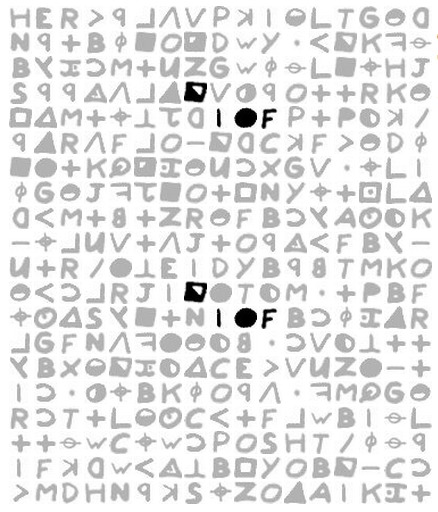
Features, or phantoms? ![]()
I’ll also repost this image which highlights several of the patterns, including underlining some interesting repeating fragments:
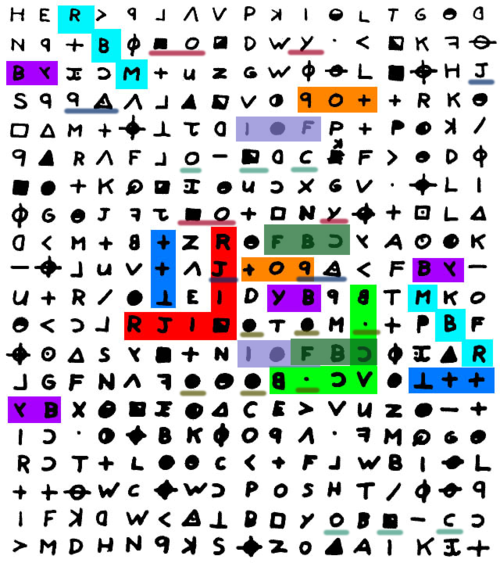
I’ve always thought it was interesting that a lot of things seem to be happening around the pivots.
Jarlve, thanks for checking my finds and for your answer. I have read the other thread you mentioned but I do not understand everything (including the maps you compiled). I have to read it again I guess =)
The map just show the locations on which a bigram repeat occurs for the inspected period. I noticed that with the 408, when looking at such maps, that at period 10 (which has a low amount of repeats) there appeared basicly what I call a repeating bigram structure. Perhaps that is bad naming but the general idea is that there is a large structure that repeats itself at an offset equal to the period and most of the repeats are involved.
Here’s another view of period 10 in the 408 where I painted one side of the structure in red. I think it is possible that the same thing is happening in the 340 at period 39 (or period 29 after mirroring). But that doesn’t tell us why two parts of the structure (the pivots) have repeating trigrams under different orientations. But with allot of bigram repeats it becomes more probable.

May you explain what do you mean with "shifted away"?
An untransposed cipher such as the 408 has a strong amount of period 1 and period 2 bigram repeats. When you apply a period 15 transposition to it period 1 becomes period 15 and period 2 becomes period 30. Now, in the 340 (after mirroring) there a strong amount of period 15 and period 29 bigram repeats. Assuming transposition, I did not understand how this was possible but I noticed one of smokie’s ciphers had a similar thing going on (though to lesser extent). And this cipher of smokie has periodical transposition with misalignment in the form of nulls.
Smokie then showed it was possible to shift the secondary period (period 30) one up or down by misaligning the transposition, though it is difficult. I still believe that this is the main reason why we are not solving the 340 under the transposition hypothesis. I think that, so far, we have not been able to replicate such a clean shift as seen in the 340. If it is real then it must be godlike.
I’ll also repost this image which highlights several of the patterns, including underlining some interesting repeating fragments:
Thanks for posting the image! Hell, thats a lot of patterns…
I wonder how many patterns like these would appear in z408. I don’t think that people had look so close into the z340 as they did in z408. Sometimes I think "that is more than a coincidence". The other day I think "the human brain is good in finding patterns everywhere….nothin special in z340". ![]()
@Jarlve:
Thank you for the explanation!
Do you think that an intended change of transposition method instead of a mistake / misalignment?
Imagine Zodiac applied a transposition method not to the whole cipher at once. Instead he transposed the upper half and the lower half separately but with the same method. Let’s say he had used a chunk based transposition with chunk size 6 and the key „5,3,4,2,1,6“. The upper half has 170 letters which leads to 28 complete chunks and 2 remaining letters which are not transposed. Same for the lower half. But in this case the pattern „5,3,4,2,1,6“ breaks in the middle of the cipher. Could this lead to a shift you described above? Maybe you could check this when applying your measurement only at distinct parts of the cipher (horizontally/vertically)? (But I am almost sure you did that already)
@Jarlve:
Thank you for the explanation!
Do you think that an intended change of transposition method instead of a mistake / misalignment?Imagine Zodiac applied a transposition method not to the whole cipher at once. Instead he transposed the upper half and the lower half separately but with the same method. Let’s say he had used a chunk based transposition with chunk size 6 and the key „5,3,4,2,1,6“. The upper half has 170 letters which leads to 28 complete chunks and 2 remaining letters which are not transposed. Same for the lower half. But in this case the pattern „5,3,4,2,1,6“ breaks in the middle of the cipher. Could this lead to a shift you described above? Maybe you could check this when applying your measurement only at distinct parts of the cipher (horizontally/vertically)? (But I am almost sure you did that already)
I don’t know if it was intended and/or accidental.
The shift I am describing exists in a specifc scheme which we refer to as periodical transposition. In the next image I’ve shown the start of period 19. We call it period 19 because the distance between 1 and 2 is 19. If you measure bigrams in this way, especially at period 15 after mirroring or flipping the 340 there is a significant spike. Because of that it is very likely that such a periodical transposition exists in the 340. This managed to go undiscovered for some 45 years.

There are other transpositions which we have found that are very similar to a periodic transposition like this although it may be hard to understand why at first.
– Unkeyed columnar transposition (the period will be equal to the length of the columns)
– Diagonal transposition (the period will be equal to the length of the diagonals)
– Skytale (it is the same as in in the image though it wraps around the cipher instead of incrementing the position)
– Mr lowe’s column shift (incrementally shift each column up or down, +1, +2, +3, etc)
– 2-dimensional period
– Column and row period
There can be additional rules, for example, what to do when your transposition revisits the same position.
In the Zodiac FBI files there exists a magic square 21 by 21. I discovered a possible link between it and the 340, they both generate period 19 bigram repeats. doranchak coded up this excellent tool http://zodiackillerciphers.com/gridmaker/ which can generate periodic transposition tables like these.

There’s also a possible link to Gareth Penn which at one point shows the exact same thing in his book Times 17.

Here’s an old visual of mine for the period shift in smokie12, which was not intended at all.

Jarlve:
I have to read all those posts about period 19 again I think. Basically period 19 is the same as resizing the cipher to width 19 and read top to bottom, left to right. Is this correct? I played around a bit with that and tried some way transpositions (zigzag). This was a good opportunity to show an example of how I implement such tests with my python library (which I will make open source I think):
I will check what a „magic square“ is, never heard that. Sounds interesting though.
The FBI files you are talking about…where can I find them? Are they disclosed?
Jarlve:
I have to read all those posts about period 19 again I think. Basically period 19 is the same as resizing the cipher to width 19 and read top to bottom, left to right. Is this correct? I played around a bit with that and tried some way transpositions (zigzag). This was a good opportunity to show an example of how I implement such tests with my python library (which I will make open source I think):
Yes, it is the same as columnar transposition.
There are other transpositions which we have found that are very similar to a periodic transposition like this although it may be hard to understand why at first.
– Unkeyed columnar transposition (the period will be equal to the length of the columns)
– Diagonal transposition (the period will be equal to the length of the diagonals)
– Skytale (it is the same as in in the image though it wraps around the cipher instead of incrementing the position)
– Mr lowe’s column shift (incrementally shift each column up or down, +1, +2, +3, etc)
– 2-dimensional period
– Column and row period
I will check what a „magic square“ is, never heard that. Sounds interesting though.
The FBI files you are talking about…where can I find them? Are they disclosed?
It basicly can be seen as a 2-dimensional period with additional custom rules. Here are some links to various released Zodiac FBI files. Some of them are copies, which are not quite identical. The first link contains the best stuff and the magic square.
https://docs.google.com/folder/d/0Bx2Zx … 1ZNc1pGX1k
http://www.zodiackillerciphers.com/?p=543
https://vault.fbi.gov/The%20Zodiac%20Killer
http://www.zodiackiller.com/fbi_index.html
http://www.zodiackillerfacts.com/galler … php?cat=25
Thanks a lot for the links Jarlve!
